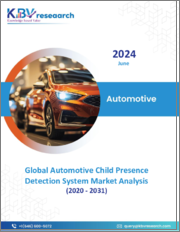
|
시장보고서
상품코드
1570991
자동차 탑승자 감지 시장 : 현황 분석 및 예측(2024-2032년)Automotive Occupant Sensing Market: Current Analysis and Forecast (2024-2032) |
||||||
자동차 탑승자 감지 시장은 예측 기간(2024-2032년) 동안 약 5.95%의 괄목할 만한 성장이 예상됩니다. 자동차 탑승자 감지 시스템의 성장 요인 중 하나는 전 세계적으로 자동차 판매가 증가하고 있다는 점입니다. 신흥국의 소득이 증가함에 따라 고객들은 보다 안전한 출퇴근을 위해 승용차 구매를 원하고 있습니다. 국제자동차산업협회(OICA)에 따르면 2020년 자동차(승용차 및 상용차 포함) 총 판매량은 7,966만 대이며, 2023년에는 9,272만 대까지 증가할 것으로 예상됩니다. 이는 같은 기간 총 성장률의 약 16.3%에 해당합니다.
또한, 인도, 중국, 미국, 인도네시아 등의 국가에서 자동차 판매량이 증가하고 있고, 자동차 제조업체와 규제 기관에서 안전이 중요한 요소 중 하나로 인식되고 있는 점을 감안하면, 자동차 탑승자 감지 시스템의 성장에 긍정적인 요인으로 작용할 수 있습니다.
이러한 요인들을 고려할 때, 향후 몇 년간 자동차 수요 증가는 자동차에 통합되는 안전 솔루션에 유리하게 작용할 것으로 예상됩니다. 또한, 가처분 소득이 증가한 고객들은 강력한 안전 시스템을 제공하는 옵션에 더 많은 관심을 기울일 것으로 예상되며, 이는 시장 성장을 더욱 촉진할 것으로 보입니다. 따라서 자동차 탑승자 감지 시스템에 대한 수요는 2024년부터 2032년 사이에 상당한 성장을 보일 것으로 예상됩니다.
자동차 탑승자 감지 센서 세계 시장은 유형별로 압력 센서, 안전벨트 장력 센서, 안전벨트 버클 센서, 이미지 센서, 중량 센서, 용량 센서, 초음파 센서, 기타로 구분됩니다. 이 중 압력 센서와 안전벨트 장력 센서가 상당한 시장 점유율을 차지하고 있습니다. 성장 요인으로는 차량에 쉽게 장착할 수 있다는 점과 다른 복잡하고 고급스러운 센서와 달리 가격이 저렴하다는 점을 들 수 있습니다. 또한, 각 카테고리는 비용을 크게 추가하지 않고도 안전 기능을 강화할 수 있기 때문에 중저가 차량과 고급 차량 모두에서 대부분의 차량에 일반적으로 사용되고 있습니다.
차량 유형에 따라 시장은 승용차와 상용차로 구분됩니다. 이 중 승용차 부문이 가장 큰 시장 점유율을 차지하고 있습니다. 특히 중동, 아시아태평양 등 개발도상국의 승용차 판매량이 증가함에 따라 자동차 탑승자 감지 시스템을 포함한 안전 기능에 대한 수요가 더욱 증가하고 있습니다.
자동차 탑승자 감지 시장의 채택을 더 잘 이해하기 위해 시장은 북미(미국, 캐나다, 기타 북미), 유럽(독일, 프랑스, 영국, 스페인, 이탈리아, 기타 유럽), 아시아태평양(중국, 일본, 인도, 기타 아시아태평양), 기타 지역으로 분석됩니다. 세계 시장 점유율을 기준으로 분석되었습니다. 아시아태평양은 자동차 탑승자 감지 시장에서 큰 비중을 차지하고 있으며, 예측 기간 동안 안정적인 성장률을 유지할 것으로 예상됩니다. 아시아태평양은 방대한 자동차 산업을 보유하고 있으며, 자동차의 과제와 잠재적인 기술 솔루션에 대한 연구 개발을 종합적으로 지원할 것으로 기대됩니다.
이 시장에 진출한 주요 기업으로는 Robert Bosch GmbH, Joyson Safety Systems, Autoliv Inc, Valeo SA, ams-OSRAM AG, IEE Smart Sensing Solutions 등이 있습니다.
목차
제1장 시장 서론
- 시장의 정의
- 주요 목적
- 이해관계자
- 제한 사항
제2장 조사 방법 또는 전제조건
- 조사 과정
- 조사 방법
- 응답자 개요
제3장 주요 요약
- 업계 요약
- 부문별 전망
- 시장 성장 힘
- 지역 전망
제4장 시장 역학
- 성장 촉진요인
- 기회
- 성장 억제요인
- 동향
- PESTEL 분석
- 수요측 분석
- 공급측 분석
- 투자 시나리오
- 업계 인사이트 : 대형 스타트업 기업과 독자적인 전략
제5장 가격 분석
- 지역별 가격 분석
- 가격에 영향을 미치는 요인
제6장 세계의 자동차용 승무원 센싱 시장 매출, 2022-2032년
제7장 시장 인사이트 : 유형별
- 압력 센서
- 안전벨트 장력 센서
- 안전벨트 버클 센서
- 이미지 센서
- 중량 센서
- 용량 센서
- 초음파 센서
- 기타
제8장 시장 인사이트 : 차량 유형별
- 승용차
- 상용차
- LCV
- HCV
제9장 시장 인사이트 : 판매채널별
- OEM
- 애프터마켓
제10장 시장 인사이트 : 지역별
- 북미
- 미국
- 캐나다
- 기타 북미
- 유럽
- 독일
- 영국
- 프랑스
- 이탈리아
- 스페인
- 기타 유럽
- 아시아태평양
- 중국
- 일본
- 인도
- 기타 아시아태평양
- 세계 기타 지역
제11장 밸류체인 분석
- 한계분석
- 시장 진출기업 리스트
제12장 경쟁 구도
- 경쟁 대시보드
- 경쟁 시장 포지셔닝 분석
- Porter의 Five Forces 분석
제13장 기업 개요
- Robert Bosch GmbH
- Joyson Safety Systems
- Autoliv Inc.
- Continental AG
- Hyundai Motor
- Flexpoint
- Denso Corporation
- Valeo SA
- ams-OSRAM AG
- IEE Smart Sensing Solutions
제14장 두자어와 전제조건
제15장 부록
LSH 24.10.28Global Automotive Occupant sensing market is witnessing a notable growth across the globe. Automotive occupant sensing system comprises of various sensor as seat belt tension sensor, pressure sensors under seat, image sensor, weight sensors, etc. These sensors help comprehend the system in the vehicle to provide added safety features as provide seat belt alarm, deploying the necessary air bags in case of collision. Additionally, these automotive occupant sensing systems also offer better passenger safety and protection with the help of image sensing and ultrasonic techniques in coordination with the advanced driver assistance systems.
The Automotive Occupant Sensing Market is expected to grow at a significant rate of around 5.95% during the forecast period (2024-2032). One of the factors that has attributed to the growth of automotive occupant sensing systems is rising sales of automotive vehicles across the globe. As the income in the emerging economies is rising the customers are looking forward to passenger cars for a safer commute. According to the International Organization of Motor Vehicle Manufacturers (OICA), the total sales of automotive (including both passenger cars and commercial vehicles) in 2020 was 79.66 million which rose to 92.72 million in year 2023. This is approximately 16.3% of total growth in the respective period.
Additionally, countries as India, China, the US, Indonesia, etc., have witnessed growth in the sales of automotives in the respective period which is a positive factor for the growth of automotive occupant sensing systems considering safety becoming one of the key factor among the automotive manufacturers and regulatory bodies.
Considering the factors mentioned it is expected that the positive growth in the demand for automobiles in the coming years would be conducive for the safety solutions integrated into the vehicles. Furthermore, the customers with the increased disposable income would further focus on the options offering a robust safety systems further promoting the market growth. Henceforth, the demand for the automotive occupant sensing systems is expected to exhibit considerable growth during 2024-2032.
Based on Type the global automotive occupant sensing market is segmented into pressure sensor, seat belt tension sensor, seat belt buckle sensor, image sensor, weight sensor, capacity sensor, ultrasonic sensor, others. Of these pressure sensor and seat belt tension sensors have held a considerable market share among all. Some of the factors attributing to the growth are easier integration into the vehicles, affordable costing as opposed to other complex and high-end sensors. Additionally, the respective categories are used commonly in majority of the vehicles both low to medium and high-end vehicles due to their enhanced safety functions without a significant addition in the cost.
Based on the vehicle type, the market is segmented into Passenger Cars and Commercial Vehicles. Of these the passenger cars segment has held a sizable market share. With the rising sales of passenger cars especially in the developing regions as the Middle East, Asia Pacific, etc., the demand for safety features including the automotive occupant sensing systems has further strengthened.
For a better understanding of the market adoption of the Automotive Occupant Sensing market, the market is analyzed based on its worldwide presence in countries such as North America (U.S., Canada, and the Rest of North America), Europe (Germany, France, U.K., Spain, Italy, Rest of Europe), Asia-Pacific (China, Japan, India, Rest of Asia-Pacific), Rest of World. Asia Pacific holds a significant share of the Automotive Occupant Sensing market and is anticipated to maintain a steady growth rate over the forecast period. Asia Pacific has a vast automotive industry, and it is looking forward to comprehensively supporting research & development around automotive challenges and their potential technological solutions.
Some of the major players operating in the market include Robert Bosch GmbH, Joyson Safety Systems, Autoliv Inc., Continental AG, Hyundai Motor Company, Flexpoint, Denso Corporation, Valeo SA, ams-OSRAM AG, and IEE Smart Sensing Solutions.
TABLE OF CONTENTS
1.MARKET INTRODUCTION
- 1.1. Market Definitions
- 1.2. Main Objective
- 1.3. Stakeholders
- 1.4. Limitation
2.RESEARCH METHODOLOGY OR ASSUMPTION
- 2.1. Research Process of the Automotive Occupant Sensing Market
- 2.2. Research Methodology of the Automotive Occupant Sensing Market
- 2.3. Respondent Profile
3.EXECUTIVE SUMMARY
- 3.1. Industry Synopsis
- 3.2. Segmental Outlook
- 3.2.1. Market Growth Intensity
- 3.3. Regional Outlook
4.MARKET DYNAMICS
- 4.1. Drivers
- 4.2. Opportunity
- 4.3. Restraints
- 4.4. Trends
- 4.5. PESTEL Analysis
- 4.6. Demand Side Analysis
- 4.7. Supply Side Analysis
- 4.7.1. Investment Scenario
- 4.7.2. Industry Insights: Leading Startups and Their Unique Strategies
5.PRICING ANALYSIS
- 5.1. Regional Pricing Analysis
- 5.2. Price Influencing Factors
6.GLOBAL AUTOMOTIVE OCCUPANT SENSING MARKET REVENUE (USD MN), 2022-2032F
7.MARKET INSIGHTS BY TYPE
- 7.1. Pressure Sensor
- 7.2. Seat Belt Tension Sensor
- 7.3. Seat Belt Buckle Sensor
- 7.4. Image Sensor
- 7.5. Weight Sensor
- 7.6. Capacity Sensor
- 7.7. Ultrasonic Sensor
- 7.8. Others
8.MARKET INSIGHTS BY VEHICLE TYPE
- 8.1. Passenger Cars
- 8.2. Commercial Vehicles
- 8.2.1. LCV
- 8.2.2. HCV
9.MARKET INSIGHTS BY SALES CHANNEL
- 9.1. OEM
- 9.2. Aftermarket
10.MARKET INSIGHTS BY REGION
- 10.1. North America
- 10.1.1. U.S.
- 10.1.2. Canada
- 10.1.3. Rest of North America
- 10.2. Europe
- 10.2.1. Germany
- 10.2.2. U.K.
- 10.2.3. France
- 10.2.4. Italy
- 10.2.5. Spain
- 10.2.6. Rest of Europe
- 10.3. Asia-Pacific
- 10.3.1. China
- 10.3.2. Japan
- 10.3.3. India
- 10.3.4. Rest of Asia-Pacific
- 10.4. Rest of World
11.VALUE CHAIN ANALYSIS
- 11.1. Marginal Analysis
- 11.2. List of Market Participants
12.COMPETITIVE LANDSCAPE
- 12.1. Competition Dashboard
- 12.2. Competitor Market Positioning Analysis
- 12.3. Porter Five Forces Analysis
13.COMPANY PROFILED
- 13.1. Robert Bosch GmbH
- 13.1.1. Company Overview
- 13.1.2. Key Financials
- 13.1.3. SWOT Analysis
- 13.1.4. Product Portfolio
- 13.1.5. Recent Developments
- 13.2. Joyson Safety Systems
- 13.3. Autoliv Inc.
- 13.4. Continental AG
- 13.5. Hyundai Motor
- 13.6. Flexpoint
- 13.7. Denso Corporation
- 13.8. Valeo SA
- 13.9. ams-OSRAM AG
- 13.10. IEE Smart Sensing Solutions


















